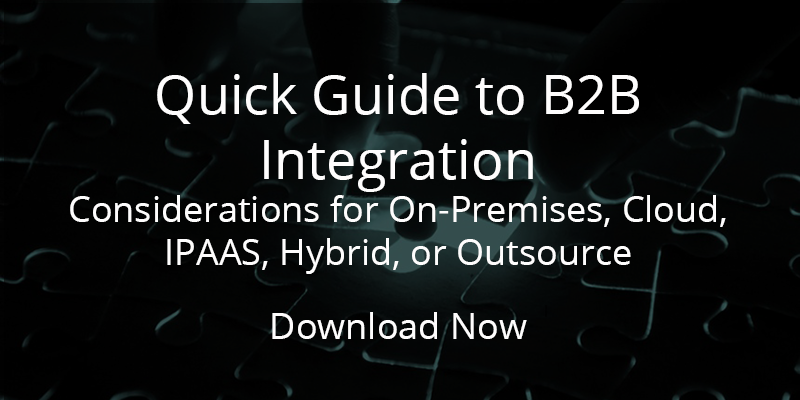
As companies look for ways to respond to the current sluggishness and uncertainty in the economy in the wake of Covid-19, IT staffing budgets often go under the microscope first. Accordingly, the term “outsourcing” enters the conversation.
While a valid and often reasonable option, when applied to EDI, MFT, EAI, and API capabilities it’s a choice companies need to consider very carefully. These IT solutions and skills— and the business processes that depend on them—have a direct impact on your company’s ability to stay competitive in today’s digitally driven economy. They also form the backbone disciplines of today’s B2B ecommerce and digitally integrated ecosystem.
Judging from the client solutions we’ve been a part of since the pandemic began, the organizations who have successfully pivoted to other products and sales channels have one thing in common— a modern business and system integration infrastructure that gives them:
- Agility
- Real time supply chain visibility
- The means to deliver a seamless experience for customers and trading partners
In this article, the last in our series on integration deployment options, we look at the outsourced integration model—its advantages, drawbacks, and in what scenarios outsourcing your integration infrastructure makes good strategic and financial sense.
What is Outsourced Integration?
While the term “outsourced integration” can mean many things to different stakeholders and decision makers, at Remedi we define it as the choice a company makes to engage an outside firm to supply the B2B integration tools, infrastructure, and labor to connect with business partners and systems.
Advantages
There are several benefits to the outsourced integration model, strategic, financial, and operational:
- Free up staff to focus on more strategic projects or other priorities
- Access to hard-to-find skill sets or industry-specific expertise
- Lower operating costs
- Ability to leverage and scale modern integration infrastructure and software applications without large capital investment
- Enhanced security protection and compliance procedures
Drawbacks
Without proper diligence, choosing the outsourced integration route can lead to significant buyer’s remorse for the following reasons:
- The service provider is unable or unwilling to staff your account with competent resources who bring critical skills such as EDI, MFT, EAI, and API
- You may experience poor response time during an outage or service issue
- The service provider may not share your commitment to quickly resolving customer or trading partner issues—or proactive steps to prevent them in the future
- You may encounter resistance or delays in responding to requests for real time visibility into project status, vendor staff performance, or performance metrics such as response time or up time
- Loss of control over your priorities and data
- Increased risks related to data security, SLA performance, and your brand reputation
Full disclosure, we’ve helped dozens of clients migrate to the outsourcing model, and for many, it has worked out well. However, these clients typically have a handful of trading partners who demand EDI (or other digital transaction) capability, and B2B connectivity isn’t a differentiator in their category.
On the other hand, we’ve also helped clients extricate themselves from a bad outsourcing relationship, renegotiating an integration carve out from full scale IT outsourcing scenarios, allowing the organization to reap the other benefits of IT outsourcing and take back control over their B2B integration functions and trading partner relationships.
Which brings up another option that, in our experience, delivers more advantages than outsourcing with fewer drawbacks.
Managed Integration Services—The Cake You Can Have and Eat
The most successful B2B integration deployments work as partnerships. At Remedi, we’re advocates of managed integration services, a business model that leverages the strengths of the customer and the managed service provider.
It’s helpful to think of managed integration services as “co-sourcing.” In this model, the customer owns (or leases) the software and chooses their preferred deployment model, while the managed integration services partner installs, tests, and manages the software.
The provider also handles ongoing EDI support duties such as trading partner coordination, mapping, and onboarding, error tracing and resolution, and architectural design and management. Under this relationship, internal IT staff can focus on other business priorities while the integration partner delivers the services they have the training and experience to execute at a high level.
With partner integrators playing roles from coordinators and mappers to developers and architects, the managed integration services model appeals to customers with an outsource mindset, growing businesses, an acquisition to absorb, or seasonal peaks because it allows them to scale the number of required integrators up or down from a baseline number according to the needs of their organization.
Final thoughts
As with any of the deployment models we’ve explored, the key is to conduct thorough due diligence before choosing an integration deployment model that involves an off-premises approach, especially one that promises dramatic savings.
While it’s critical to keep costs as low as reasonably possible without sacrificing quality or creativity, we’d advise you avoid any proposal with a price tag so far below others on your short list that it seems like an outlier.
Once you’ve signed the contract and you’re deployed on your new provider, it’s difficult, costly, and time consuming to untangle your operations from the third-party’s control. More critically, the actions and processes of the services provider will define how easy (or difficult) people think you are to do business with.
As far as trading partners and customers know, these transaction experiences are not delivered by an outside entity engaged by your company. These experiences are your company— and your reputation. Choose wisely. Be as certain as you can that what you’ll save by outsourcing is worth more than what you could lose.
As you weigh your options, you might find our previous articles in this series useful:
Understanding Your Integration Options: On-Premises, Cloud, Hybrid and Outsourced
When to Choose an On-Premises Integration Solution
When to Choose a Cloud Integration Solution
When to Choose the Hybrid Approach
About Remedi
Remedi Electronic Commerce Group helps companies save time and money, provide a better customer experience, and quickly respond to new opportunities using integration and B2B ecommerce solutions built for a digitally driven economy.



